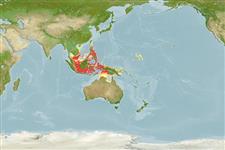Teleostei (teleosts) >
Acropomatiformes (Oceanic basses) >
Hemerocoetidae (Indo-Pacific duckbills)
Etymology: Pteropsaron: Greek, pteron = wing, fin + Greek, psaron = grey, with different colours (Ref. 45335); springeri: Named for Victor G. Springer..
Environment: milieu / climate zone / depth range / distribution range
Ecology
Marine; demersal; depth range 18 - 73 m (Ref. 75753). Tropical
Western Central Pacific: Indonesia and the Philippines; probably including Palau.
Size / Weight / Age
Maturity: Lm ? range ? - ? cm
Max length : 2.8 cm SL male/unsexed; (Ref. 75753)
Short description
Identification keys | Morphology | Morphometrics
Dorsal spines (total): 3; Dorsal soft rays (total): 20 - 23; Anal soft rays: 20 - 25; Vertebrae: 35 - 36. This species differs from other species of the Pteropsaron/Osopsaron complex in having only 3 dorsal spines which are displaced anteriorly to lie over the posterior end of the skull, and associated modification of the anteriormost 3 pterygiophores and neural spines; D III, 20-23; A 24-25; vertebrae 35-36 (Ref. 75753).
Usually found in sloping sand bottoms to 73 m (Ref. 90102).
Life cycle and mating behavior
Maturities | Reproduction | Spawnings | Egg(s) | Fecundities | Larvae
Smith, D.G. and G.D. Johnson, 2007. A new species of Pteropsaron (Teleostei: Trichonotidae: Hemerocoetinae) from the Western Pacific, with notes on related species. Copeia 2007(2):364-377. (Ref. 75753)
IUCN Red List Status (Ref. 130435)
Human uses
Tools
Special reports
Download XML
Internet sources
Estimates based on models
Preferred temperature (Ref.
123201): 27.9 - 29, mean 28.6 °C (based on 122 cells).
Phylogenetic diversity index (Ref.
82804): PD
50 = 0.5020 [Uniqueness, from 0.5 = low to 2.0 = high].
Bayesian length-weight: a=0.00389 (0.00180 - 0.00842), b=3.12 (2.94 - 3.30), in cm total length, based on all LWR estimates for this body shape (Ref.
93245).
Trophic level (Ref.
69278): 3.1 ±0.4 se; based on size and trophs of closest relatives
Resilience (Ref.
120179): High, minimum population doubling time less than 15 months (Preliminary K or Fecundity.).
Fishing Vulnerability (Ref.
59153): Low vulnerability (10 of 100).
